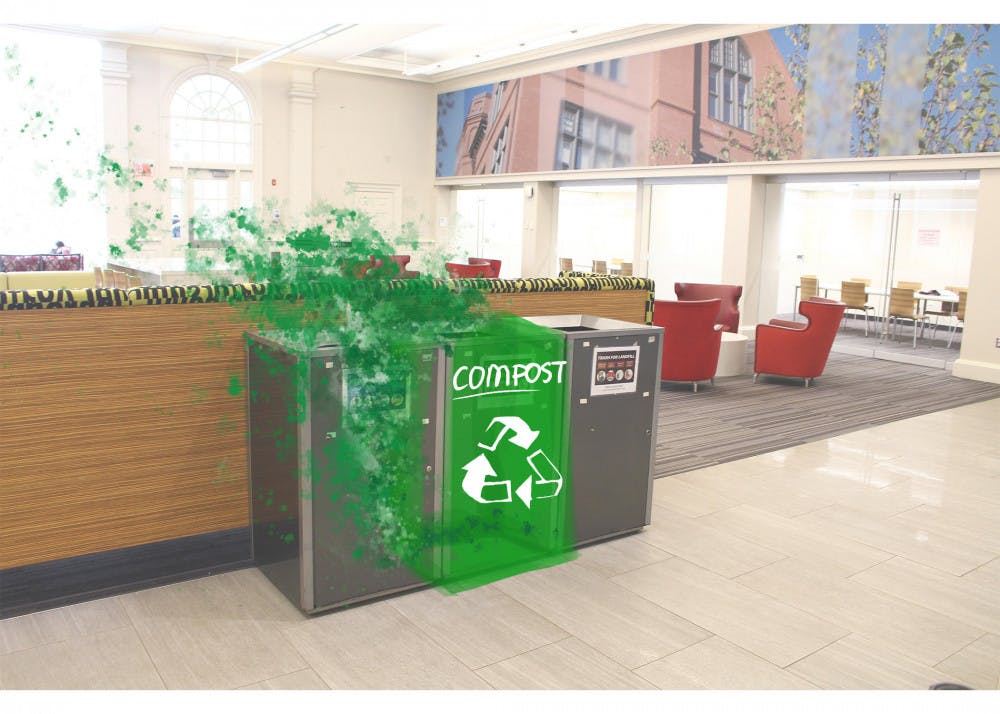After returning from summer break, students noticed that some of their favorite dining halls were missing a previous staple: compost bins.
“A lot of my friends are upset and often ask, ‘what’s up with that?’” said Jessica Minker ’21, a member of SCRAP, the University’s student compost initiative.
Front-of-house compost has yet to be reinstated in Andrews Commons and the Blue Room, after problems with high levels of cross-contamination and a lack of compliance with composting guidelines led to their removal last September, wrote Jessica Berry, director of the Office of Sustainability, in an email to The Herald.
The University had implemented composting in Andrews and the Blue Room during the fall 2016 semester as part of a pilot program “to test the feasibility of having front-of-house composting at retail dining locations,” wrote Berry. It became clear from the pilot program that the level of contamination in the compost in Andrews and the Blue Room was resulting “in the (compost) material simply being thrown in the trash,” Berry wrote. The decision to remove composting from these dining halls “was jointly made by Facilities, Brown Dining Services and leadership,” Berry added. Composting bins remain in multiple dining locations on campus, including the Sharpe Refectory.
With every contaminated compost bin, the University has to pay $75 to the compost collecting facility, “and every day every compost bin was contaminated, so it really adds up,” said DeeAnn Guo ’21, a member of SCRAP and an employee at the Office of Sustainability. “It was just throwing money away,” she added.
Though 43 tons of food were composted in Andrews last year, and composting bins cost about $2,000 to install, these units remain “in storage for the future,” Berry wrote.
While the Ratty and the Verney-Woolley Dining Hall utilize reusable plates, there is more plastic in Andrews and the Blue Room, which increases the risk of contamination, said Carlyn Chrabaszcz ’21, the leader of SCRAP. Even with the introduction of compostable containers in the Blue Room, there were high levels of contamination, Chrabaszcz added. The Blue Room also draws a lot of visitors, many of who might not be familiar with the University’s composting system, Guo said.
Making dining halls compost-friendly requires larger systemic changes, Guo added. Andrews lacks reusable dishes in part because it is “really small in comparison to the Ratty … so there’s really no place to put in the dish washing operation,” Guo said.
Brown is not required to compost as per the guidelines of the food waste ban — a state law compelling institutions to compost if they meet certain criteria — because there is not a capable industrial compost facility within fifteen miles of the University, Berry wrote. Instead the University’s compost initiatives are a choice stemming from its sustainability principles and goals, she added.
With heightened urgency over the effects of climate change, composting is becoming a “really important” way to close the cycle of waste, Guo said. The process allows food waste “to decompose in a way that slows climate change because it doesn’t release methane, while food that goes into a landfill usually would,” she added.
While members of SCRAP see enthusiasm for composting, “not everyone wants to do the dirty work, ” Chrabaszcz said.
The University has taken a step back on composting for now, but they continue “to look at ways to divert organic material and certainly keep Andrews in those conversations,” Berry wrote.





